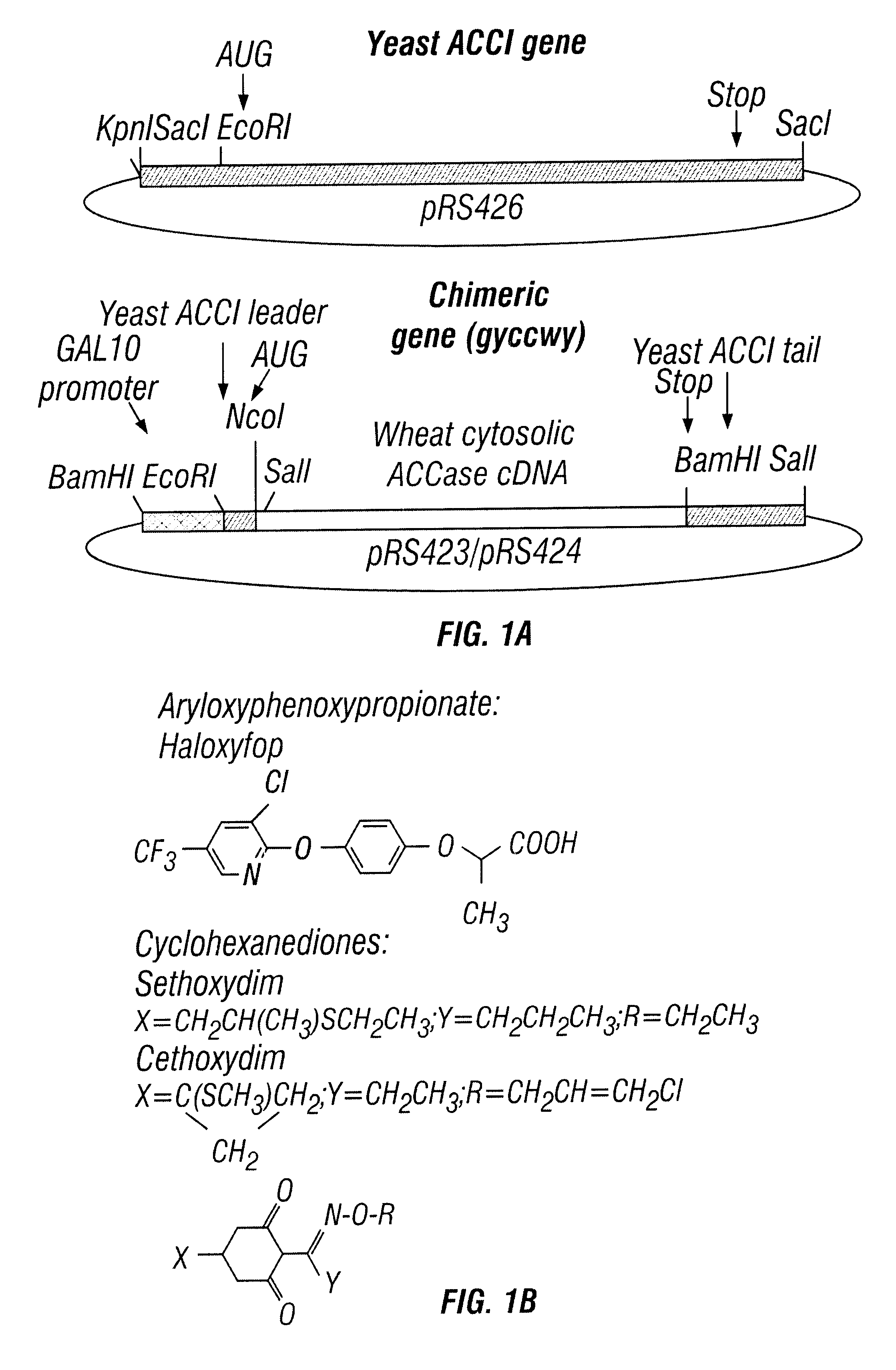Nucleic acid segments encoding wheat acetyl-CoA carboxylase
a technology of acetylcoa carboxylase and nucleic acid, which is applied in the field of plant genetics and enzymes, can solve the problems of ineffective herbicides of aryloxyphenoxypropionate and cyclohexane-1,3-dione groups in the agriculture of these important grain crops, and achieve the effect of improving the quality and degree of specific hybrid molecules, and increasing the stability and selectivity of hybrids
- Summary
- Abstract
- Description
- Claims
- Application Information
AI Technical Summary
Benefits of technology
Problems solved by technology
Method used
Image
Examples
example 1
5.1 Example 1
Effects of Haloxyfop of Wheat Cytosolic ACCase
The effect of haloxyfop, one of the aryloxyphenoxypropionate herbicides has been tested, on the activity of ACCase from wheat germ and from wheat seedling leaves. For the in vitro assay of ACCase activity, 1-8 .mu.l aliquots of ACCase preparations were incubated for 45 min at 37.degree. C. with 20 .mu.l of 100-200 mM KCl, 200 mM Tris-HCl pH 8.0, 10 mM MgCl.sub.2, 2 mM ATP, 2 mM DTT, 2 mM .sup.14 C-NaHCO.sub.3, and where indicated 1 mM Ac-CoA, in a final volume of 40 .mu.l. The reaction was stopped by adding 4 .mu.l of concentrated HCl 30-40 .mu.l aliquots of the reaction mixture were spotted on filter paper and dried, and acid-stable radioactivity was measured using scintillation cocktail. Haloxyfop was added as the Tris salt of the acid, generously supplied by J. Secor of Dow-Elanco.
For the in vivo assay of ACCase activity, 2-week old seedlings of wheat (Triticum aestivum cv. Era) were cut about 1 cm below the first leaf an...
example 2
5.2 Example 2
Cloning and Sequencing of Wheat Cytosolic ACCase cDNA
5.2.1 Materials and Methods
5.2.1.1 PCR.TM. Amplification
Degenerate PCR.TM. primers were based on the alignment of amino acid sequences of the following proteins (accession numbers in brackets): rat (J03808) and chicken (J03541) ACCases; E. coli (M80458, M79446, X14825, M32214), Anabaena 7120 (L14862, L14863) and Synechococcus 7942 BCs and BCCPs; rat (M22631) and human (X14608) propionyl-coenzyme A carboxylase ("subunit): yeast (J03889) pyruvate carboxylase: Propionibacterium shermanii (M11738) transcarboxylase (1.3S subunit) and Klebsiella pneutmonia (J03885) oxaloacetate decarboxylase (a subunit). Each primer consisted of a 14-nucleotide specific sequence based on the amino acid sequence and a 6- or 8-nucleotide extension at the 5'-end.
Poly(A).sup.+ RNA from 8-day old plants (Triticum aestivum var. Era) was used for the synthesis of the first strand of cDNA with random hexamers as primers for AMV reverse transcriptas...
example 3
5.3 Example 3
DNA Compositions Encoding a Wheat Cytosolic ACCase
This example describes the cloning and DNA sequence of the entire gene encoding wheat (var. flard Red Winter Tam 107) acetyl-CoA carboxylase (ACCase). Comparison of the 12-kb genomic sequence with the 7.4-kb cDNA sequence reported in Example 2 revealed 29 introns. Within the coding region, the exon sequence is 98% identical to the wheat cDNA sequence. A second ACCase gene was identified by sequencing fragments of genomic clones that include the first two exons and the first intron. Additional transcripts were detected by 5'- and 3'-RACE analysis. One set of transcripts had 5'-end sequence identical to the cDNA found previously and another set was identical to the gene reported here. The 3'-RACE clones fall into four distinguishable sequence sets, bringing the number of ACCase sequences to six. None of these cDNA or genomic clones encode a chloroplast targeting signal. Identification of six different sequences suggests th...
PUM
| Property | Measurement | Unit |
|---|---|---|
| temperatures | aaaaa | aaaaa |
| temperatures | aaaaa | aaaaa |
| volume | aaaaa | aaaaa |
Abstract
Description
Claims
Application Information
 Login to View More
Login to View More - R&D
- Intellectual Property
- Life Sciences
- Materials
- Tech Scout
- Unparalleled Data Quality
- Higher Quality Content
- 60% Fewer Hallucinations
Browse by: Latest US Patents, China's latest patents, Technical Efficacy Thesaurus, Application Domain, Technology Topic, Popular Technical Reports.
© 2025 PatSnap. All rights reserved.Legal|Privacy policy|Modern Slavery Act Transparency Statement|Sitemap|About US| Contact US: help@patsnap.com

